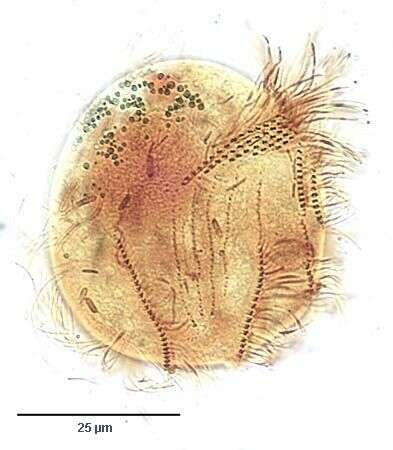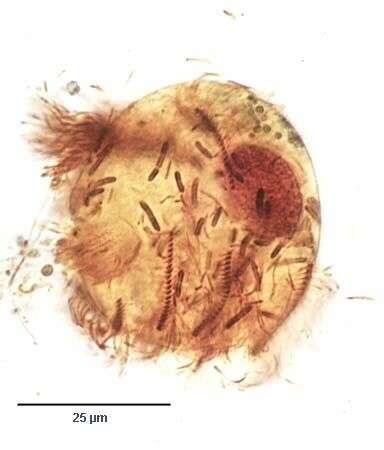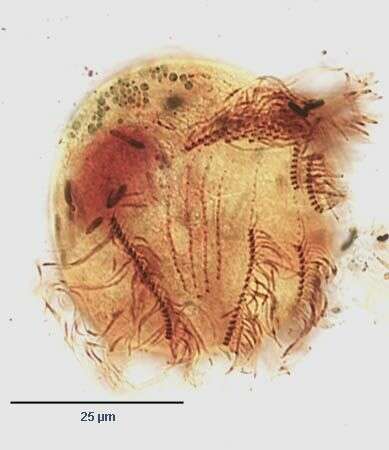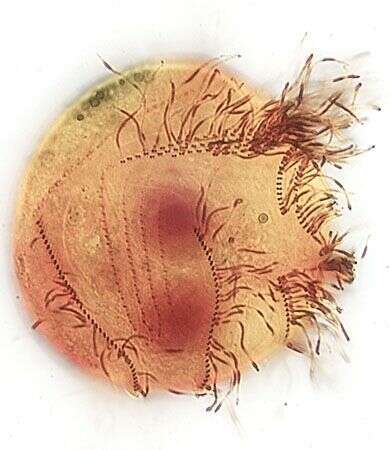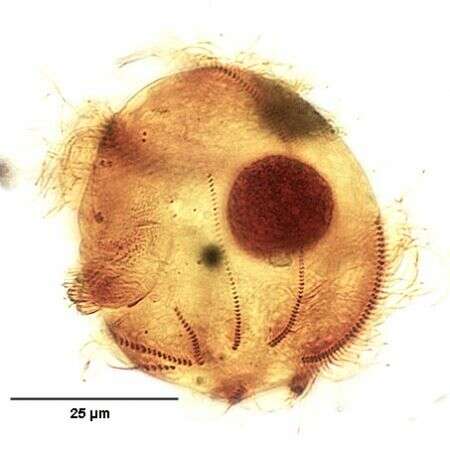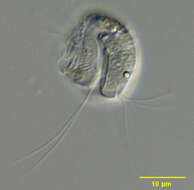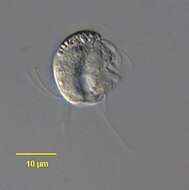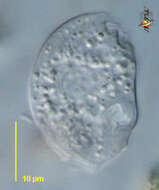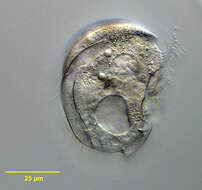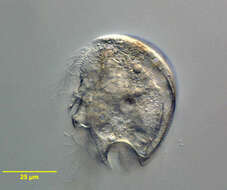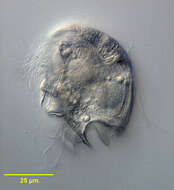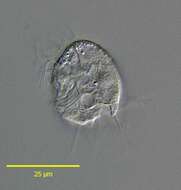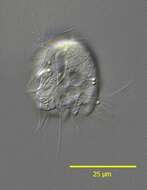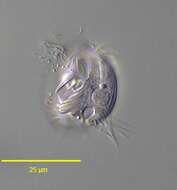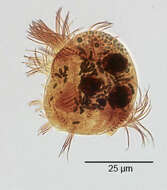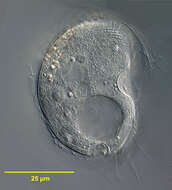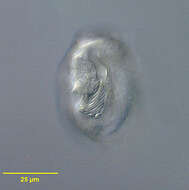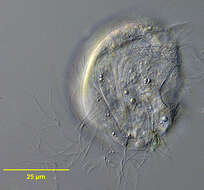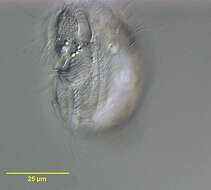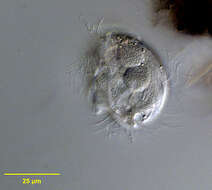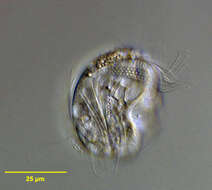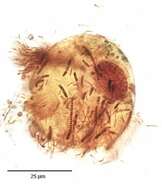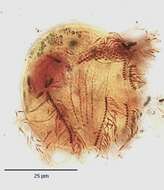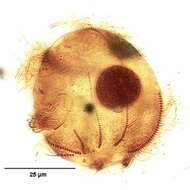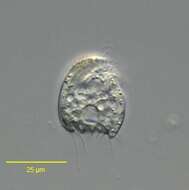-
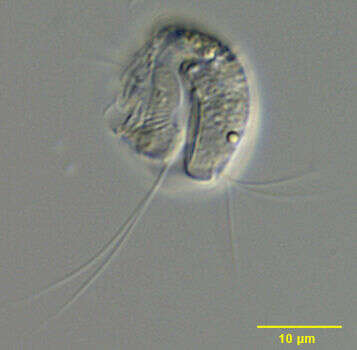
Portrait (left side) of the small Odontostome ciliate, Mylestoma pusillum (Kahl,1932). M. pusillum has a rigid armored pellicle typical of the Odontostomes. The cell is laterally compressed. The truncate posterior lacks spines, distinguishing Mylestoma pusillum from Epalxa, Saprodinium and Atopodinium. The dorsum is broadly convex and the ventral surface flattened. There is a deep longitudinal pellicular groove on the left side (seen well in this image). The tooth-like projections anterior and posterior to the cytostome are seen in this image. The adoral zone of membranelles is seen in this image as an area of transverse striation. The somatic ciliature is strongly reduced to a few perizonal kineties anterior to the cytostome and two sparse groups of long cirri posteriorly, one on either side of the longitudinal pellicular groove. There is a single elliptical macronucleus. There is a single posterior contractile vacuole. Yellow-brown refractile granules are seen in the cytoplasm. Like other Odontostomes, Mylestoma is sapropelic. Collected from bottom sediment of a freshwater aquaculture tank at a Koi farm near Boise, Idaho December 2003. DIC optics.
-
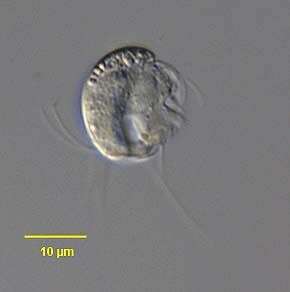
Portrait (right side) of the small Odontostome ciliate, Mylestoma pusillum (Kahl,1932). M. pusillum has a rigid armored pellicle typical of the Odontostomes. The cell is laterally compressed. The truncate posterior lacks spines, distinguishing Mylestoma pusillum from Epalxa, Saprodinium and Atopodinium. The dorsum is broadly convex and the ventral surface flattened. There is a deep longitudinal pellicular groove on the left side (seen well in this image). The tooth-like projections anterior and posterior to the cytostome are seen in this image. The adoral zone of membranelles is seen in this image as an area of transverse striation. The somatic ciliature is strongly reduced to a few perizonal kineties anterior to the cytostome (seen in this image) and two sparse groups of long cirri posteriorly, one on either side of the longitudinal pellicular groove. There is a single elliptical macronucleus. There is a single posterior contractile vacuole (seen well in this image). Yellow-brown refractile granules are seen in the cytoplasm. Like other Odontostomes, Mylestoma is sapropelic. Collected from bottom sediment of a freshwater aquaculture tank at a Koi farm near Boise, Idaho December 2003. DIC optics.
-
Epalxella (ee-palk-sell-a) is an odontostome ciliate. This is a small group of small flattened and sparsely ciliated ciliates which are most usually found in anoxic habitats. They have a small group of ciliary organelles associated with the mouth - the clear area at about 4 o clock. Differential interference contrast.
-
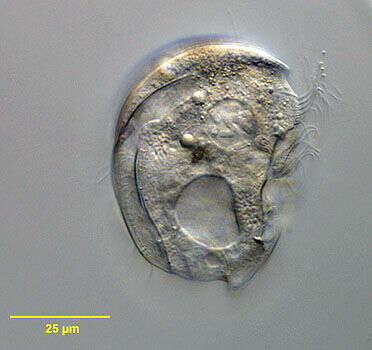
Portrait (right side) of the sapropelic odontostome ciliate, Epalxella antiquorum (Penard, 1922) Corliss, 1960 (synonymous with the preoccupied Epalxis). The cell has a clear rigid pellicle with a broad lenticular outline. The body is strongly laterally compressed. The dorsum is broadly rounded. The right side is broadly truncate posteriorly with a blunt spine on the ventral margin. The posterior side on the left terminates in 5-7 blunt spines. The spines do not terminate in needle-like processes seen in the similar genus, Saprodinium. The right and left surfaces of the pellicle bear longitudinal folds and ridges. A perizonal ciliary complex with 5 kineties and two shorter kineties runs across the ventral surface for a short distance onto the left and a longer distance onto the right surface anterior to the cytostome. The cytostome and adoral zone of membranelles is in the middle of the ventral surface. There is a prominent tooth-like spine at the anterior edge of the cytostome. The longitudinal somatic kineties are located on the pellicular ridges of the left surface and the dorsal and ventral edge of the right side. They do not extend more than 1/3 body length. The single contractile vacuole is located posteriorly. There are either two or four macronuclei. The cytoplasm contains methanogenic bacteria. Refractile brown cytoplasmic granules accumulate anteriorly. Collected from hydrogen sulfide- rich bottom sediments of slow-flowing freshwater stream near Boise, Idaho March 2004. DIC.
-
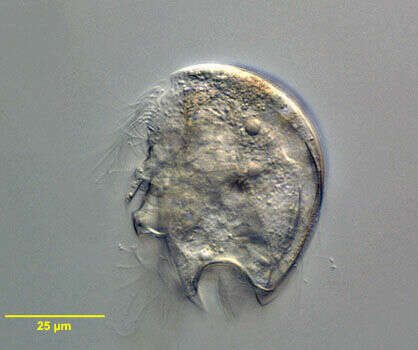
Portrait (left side) of the sapropelic odontostome ciliate, Epalxella antiquorum (Penard, 1922) Corliss, 1960 (synonymous with the preoccupied Epalxis). The cell has a clear rigid pellicle with a broad lenticular outline. The body is strongly laterally compressed. The dorsum is broadly rounded. The right side is broadly truncate posteriorly with a blunt spine on the ventral margin. The posterior side on the left terminates in 5-7 blunt spines. The spines do not terminate in needle-like processes seen in the similar genus, Saprodinium. The right and left surfaces of the pellicle bear longitudinal folds and ridges. A perizonal ciliary complex with 5 kineties and two shorter kineties runs across the ventral surface for a short distance onto the left and a longer distance onto the right surface anterior to the cytostome. The cytostome and adoral zone of membranelles is in the middle of the ventral surface. There is a prominent tooth-like spine at the anterior edge of the cytostome. The longitudinal somatic kineties are located on the pellicular ridges of the left surface and the dorsal and ventral edge of the right side. They do not extend more than 1/3 body length. The single contractile vacuole is located posteriorly. There are either two or four macronuclei. The cytoplasm contains methanogenic bacteria. Refractile brown cytoplasmic granules accumulate anteriorly. Collected from hydrogen sulfide- rich bottom sediments of slow-flowing freshwater stream near Boise, Idaho March 2004. DIC.
-
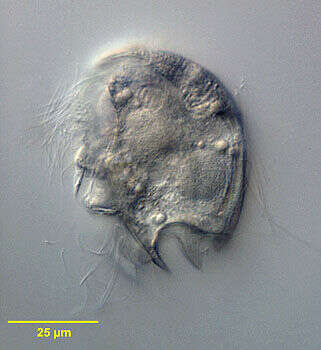
Portrait (right side) of the sapropelic odontostome ciliate, Epalxella antiquorum (Penard, 1922) Corliss, 1960 (synonymous with the preoccupied Epalxis). The cell has a clear rigid pellicle with a broad lenticular outline. The body is strongly laterally compressed. The dorsum is broadly rounded. The right side is broadly truncate posteriorly with a blunt spine on the ventral margin. The posterior side on the left terminates in 5-7 blunt spines. The spines do not terminate in needle-like processes seen in the similar genus, Saprodinium. The right and left surfaces of the pellicle bear longitudinal folds and ridges. A perizonal ciliary complex with 5 kineties and two shorter kineties runs across the ventral surface for a short distance onto the left and a longer distance onto the right surface anterior to the cytostome. The cytostome and adoral zone of membranelles is in the middle of the ventral surface. There is a prominent tooth-like spine at the anterior edge of the cytostome. The longitudinal somatic kineties are located on the pellicular ridges of the left surface and the dorsal and ventral edge of the right side. They do not extend more than 1/3 body length. The single contractile vacuole is located posteriorly. There are either two (as seen in this image) or four macronuclei. The cytoplasm contains methanogenic bacteria. Refractile brown cytoplasmic granules accumulate anteriorly. Collected from hydrogen sulfide- rich bottom sediments of slow-flowing freshwater stream near Boise, Idaho March 2004. DIC.
-
Portrait (left side) of the sapropelic odontostome ciliate, Epalxella exigua (Penard, 1922) Corliss, 1960. Synonymous with the preoccupied Epalxis. Collected from bottom sediments of a rain barrel; Boise, Idaho. DIC. This image was taken by William Bourland. He now uses a Zeiss Axioskop 2 with a Spot Insight CCD camera (Diagnostic Instruments).
-
Portrait (right side) of the sapropelic odontostome ciliate, Epalxella exigua (Penard, 1922) Corliss, 1960. Synonymous with the preoccupied Epalxis. Collected from bottom sediments of a rain barrel; Boise, Idaho. DIC. This image was taken by William Bourland. He now uses a Zeiss Axioskop 2 with a Spot Insight CCD camera (Diagnostic Instruments).
-
Portrait (left side) of the sapropelic odontostome ciliate, Epalxella exigua (Penard, 1922) Corliss, 1960. Synonymous with the preoccupied Epalxis. Collected from bottom sediments of a rain barrel; Boise, Idaho. DIC. This image was taken by William Bourland. He now uses a Zeiss Axioskop 2 with a Spot Insight CCD camera (Diagnostic Instruments).
-
Portrait (right side) of the sapropelic odontostome ciliate, Epalxella exigua (Penard, 1922) Corliss, 1960. Synonymous with the preoccupied Epalxis. Collected from bottom sediments of a rain barrel; Boise, Idaho. DIC. This image was taken by William Bourland. He now uses a Zeiss Axioskop 2 with a Spot Insight CCD camera (Diagnostic Instruments).
-
Infraciliature (left side) of the sapropelic odontostome ciliate, Epalxella exigua (Penard, 1922) Corliss, 1960. Synonymous with the preoccupied Epalxis. Collected from bottom sediments of a rain barrel; Boise, Idaho.Stained by the silver carbonate technique (see Foissner, W. Europ. J. Protistol., 27:313-330;1991).Brightfield. This image was taken by William Bourland. He now uses a Zeiss Axioskop 2 with a Spot Insight CCD camera (Diagnostic Instruments).
-
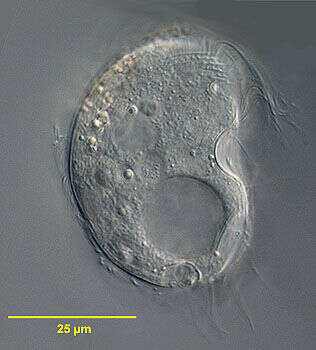
Portrait (right side) of the odontostome ciliate, Pelodinium reniforme (Lauterborn,1908). The genus is monospecific. The cell outline is broadly reniform and laterally compressed. The right surface is slightly convex. The clear rigid pellicle bears inconspicuous longitudinal ribs. A small midline posterior indentation is bordered by 6 short blunt spines (3 each on the right and left surfaces). The cytostome and adoral zone of membranelles are located on the mid-portion of the ventral surface (not seen in this view). There is a prominent sharp tooth-like spine anterior to the cytostome. The frontal zone of kineties (5 single and 2 double rows) wraps from the left surface around the ventrum and onto the right surface to the midline. The somatic ciliature is reduced to 4 right and 3 left longitudinal kineties some of which extend at least ½ the body length. The ovoid macronucleus may be single or bipartite. There is a single posterior contractile vacuole near the cytostome. There are symbiotic methanogenic bacteria in the cytoplasm. Brownish refractile granules are clustered anteriorly. Collected from hypoxic sediment of standing freshwater near Boise, Idaho February 2004. DIC optics.
-
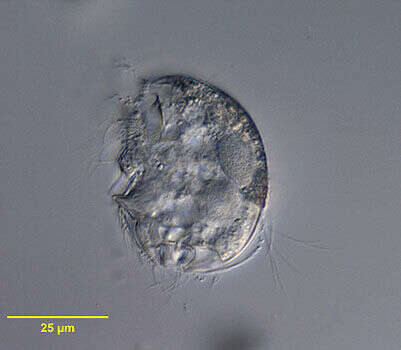
Portrait (left side) of the odontostome ciliate, Pelodinium reniforme (Lauterborn,1908). The genus is monospecific. The cell outline is broadly reniform and laterally compressed. The right surface is slightly convex. The clear rigid pellicle bears inconspicuous longitudinal ribs. A small midline posterior indentation is bordered by 6 short blunt spines (3 each on the right and left surfaces). The cytostome and adoral zone of membranelles are located on the mid-portion of the ventral surface (not seen in this view). There is a prominent sharp tooth-like spine anterior to the cytostome. The frontal zone of kineties (5 single and 2 double rows) wraps from the left surface around the ventrum and onto the right surface to the midline. The somatic ciliature is reduced to 4 right and 3 left longitudinal kineties some of which extend at least ½ the body length. The ovoid macronucleus may be single or bipartite. There is a single posterior contractile vacuole near the cytostome. There are symbiotic methanogenic bacteria in the cytoplasm. Brownish refractile granules are clustered anteriorly. Collected from hypoxic sediment of standing freshwater near Boise, Idaho February 2004. DIC optics.
-
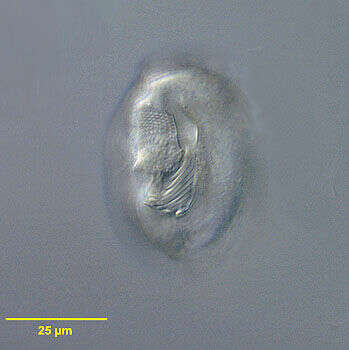
Left ventrolateral view of the odontostome ciliate, Pelodinium reniforme (Lauterborn,1908). The genus is monospecific. The cell outline is broadly reniform and laterally compressed. The right surface is slightly convex. The clear rigid pellicle bears inconspicuous longitudinal ribs. A small midline posterior indentation is bordered by 6 short blunt spines (3 each on the right and left surfaces). The large cytostome and prominent adoral zone of membranelles are located on the mid-portion of the ventral surface (seen in this view). There is a prominent sharp tooth-like spine anterior to the cytostome. The frontal zone of kineties (5 single and 2 double rows) wraps from the left surface around the ventrum and onto the right surface to the midline. The somatic ciliature is reduced to 4 right and 3 left longitudinal kineties some of which extend at least ½ the body length. The ovoid macronucleus may be single or bipartite. There is a single posterior contractile vacuole near the cytostome. There are symbiotic methanogenic bacteria in the cytoplasm. Brownish refractile granules are clustered anteriorly. Collected from hypoxic sediment of standing freshwater near Boise, Idaho February 2004. DIC optics.
-

Portrait (right side) of the odontostome ciliate, Pelodinium reniforme (Lauterborn,1908). The genus is monospecific. The cell outline is broadly reniform and laterally compressed. The right surface is slightly convex. The clear rigid pellicle bears inconspicuous longitudinal ribs. A small midline posterior indentation is bordered by 6 short blunt spines (3 each on the right and left surfaces). The cytostome and adoral zone of membranelles are located on the mid-portion of the ventral surface (not seen in this view). There is a prominent sharp tooth-like spine anterior to the cytostome. The frontal zone of kineties (5 single and 2 double rows) wraps from the left surface around the ventrum and onto the right surface to the midline. The somatic ciliature is reduced to 4 right and 3 left longitudinal kineties some of which extend at least ½ the body length. The ovoid macronucleus may be single or bipartite. There is a single posterior contractile vacuole near the cytostome. There are symbiotic methanogenic bacteria in the cytoplasm. Brownish refractile granules are clustered anteriorly. Collected from hypoxic sediment of standing freshwater near Boise, Idaho February 2004. DIC optics.
-
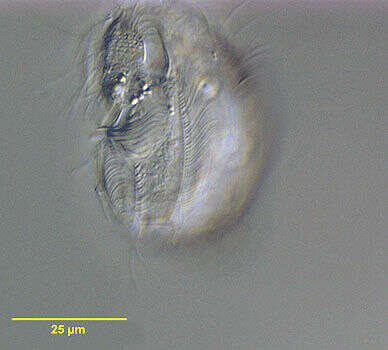
Left side of the odontostome ciliate, Pelodinium reniforme (Lauterborn,1908). The genus is monospecific. The cell outline is broadly reniform and laterally compressed. The right surface is slightly convex. The clear rigid pellicle bears inconspicuous longitudinal ribs. A small midline posterior indentation is bordered by 6 short blunt spines (3 each on the right and left surfaces). The cytostome and adoral zone of membranelles are located on the mid-portion of the ventral surface (not seen in this view). There is a prominent sharp tooth-like spine anterior to the cytostome. The frontal zone of kineties (5 single and 2 double rows) wraps from the left surface around the ventrum and onto the right surface to the midline. The somatic ciliature is reduced to 4 right and 3 left longitudinal kineties some of which extend at least ½ the body length. The ovoid macronucleus may be single or bipartite. There is a single posterior contractile vacuole near the cytostome. There are symbiotic methanogenic bacteria in the cytoplasm. Brownish refractile granules are clustered anteriorly. Collected from hypoxic sediment of standing freshwater near Boise, Idaho February 2004. DIC optics.
-
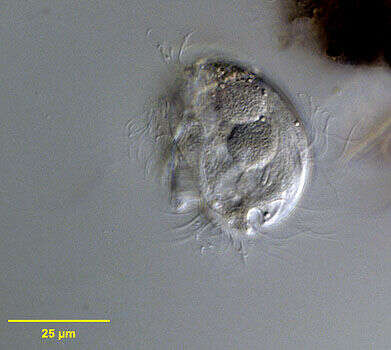
Portrait (left side) of the odontostome ciliate, Pelodinium reniforme (Lauterborn,1908). The genus is monospecific. The cell outline is broadly reniform and laterally compressed. The right surface is slightly convex. The clear rigid pellicle bears inconspicuous longitudinal ribs. A small midline posterior indentation is bordered by 6 short blunt spines (3 each on the right and left surfaces). The cytostome and adoral zone of membranelles are located on the mid-portion of the ventral surface (not seen in this view). There is a prominent sharp tooth-like spine anterior to the cytostome. The frontal zone of kineties (5 single and 2 double rows) wraps from the left surface around the ventrum and onto the right surface to the midline. The somatic ciliature is reduced to 4 right and 3 left longitudinal kineties some of which extend at least ½ the body length. The ovoid macronucleus may be single or bipartite (as seen here). There is a single posterior contractile vacuole near the cytostome. There are symbiotic methanogenic bacteria in the cytoplasm. Brownish refractile granules are clustered anteriorly. Collected from hypoxic sediment of standing freshwater near Boise, Idaho February 2004. DIC optics.
-

Surface view (right side) of the odontostome ciliate, Pelodinium reniforme (Lauterborn,1908). The genus is monospecific. The cell outline is broadly reniform and laterally compressed. The right surface is slightly convex. The clear rigid pellicle bears inconspicuous longitudinal ribs. A small midline posterior indentation is bordered by 6 short blunt spines (3 each on the right and left surfaces). The cytostome and adoral zone of membranelles are located on the mid-portion of the ventral surface (not seen in this view). There is a prominent sharp tooth-like spine anterior to the cytostome. The frontal zone of kineties (5 single and 2 double rows) wraps from the left surface around the ventrum and onto the right surface to the midline. The somatic ciliature is reduced to 4 right and 3 left longitudinal kineties some of which extend at least ½ the body length. The ovoid macronucleus may be single or bipartite. There is a single posterior contractile vacuole near the cytostome. There are symbiotic methanogenic bacteria in the cytoplasm. Brownish refractile granules are clustered anteriorly. Collected from hypoxic sediment of standing freshwater near Boise, Idaho February 2004. DIC optics.
-
Stained by the silver carbonate technique (see Foissner, W. Europ. J. Protistol., 27:313-330;1991).Brightfield.
-
Densely stained methanogenic bacilli are visble in the cytoplasm.Stained by the silver carbonate technique (see Foissner, W. Europ. J. Protistol., 27:313-330;1991).Brightfield.
-
Stained by the silver carbonate technique (see Foissner, W. Europ. J. Protistol., 27:313-330;1991).Brightfield.
-
Stained by the silver carbonate technique (see Foissner, W. Europ. J. Protistol., 27:313-330;1991).Brightfield.
-
This specimen has a single macronucleus.Stained by the silver carbonate technique (see Foissner, W. Europ. J. Protistol., 27:313-330;1991).Brightfield.
-
Right side view of the odontostome ciliate, Saprodinium putrinium (Lackey, 1925).Collected from the bottom sediments of an organically enriched freshwater pond near Boise, Idaho. DIC.




















